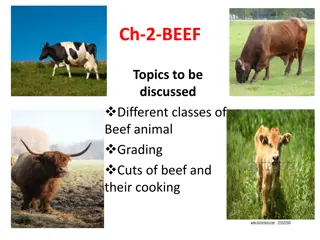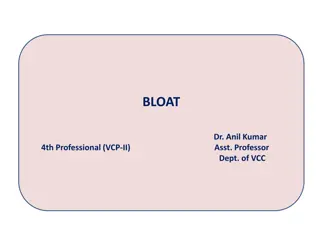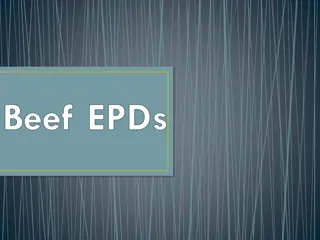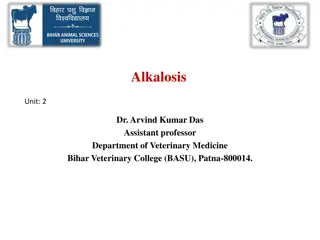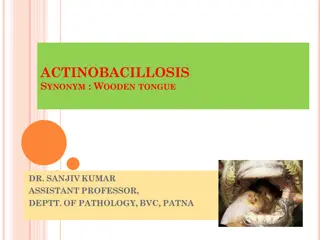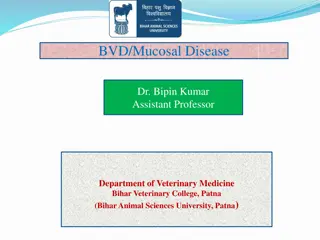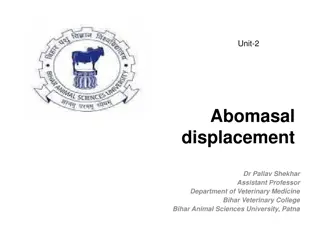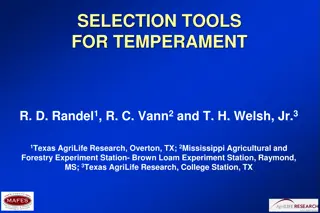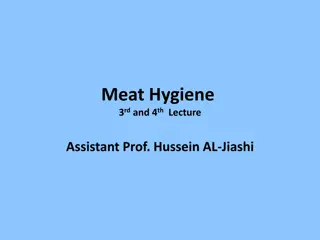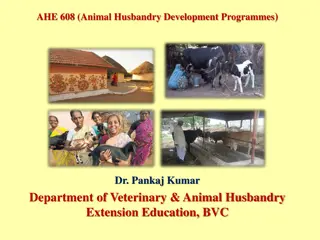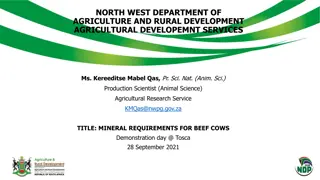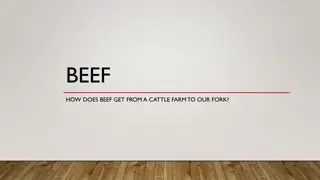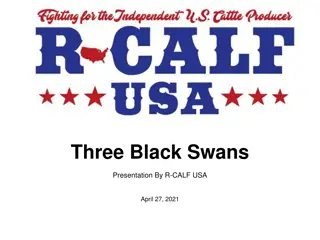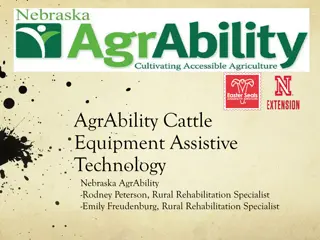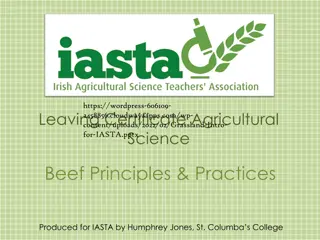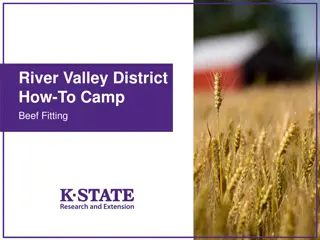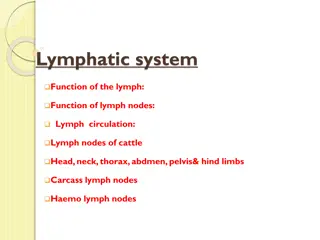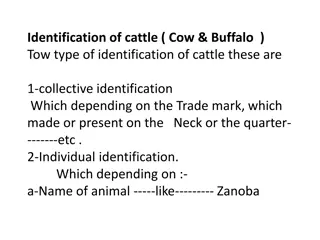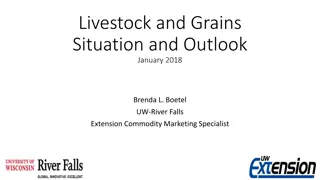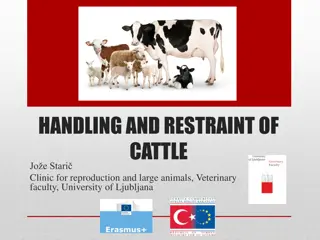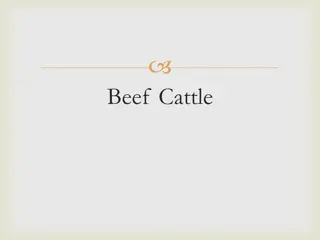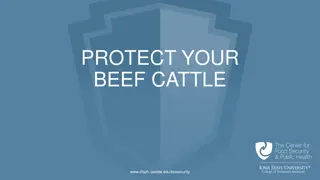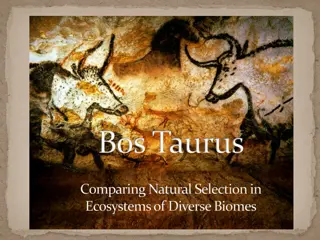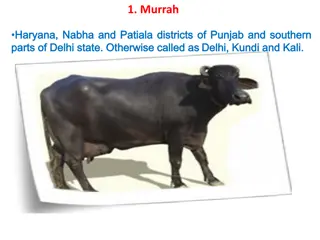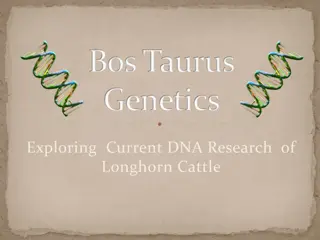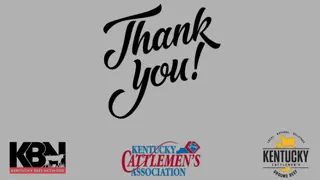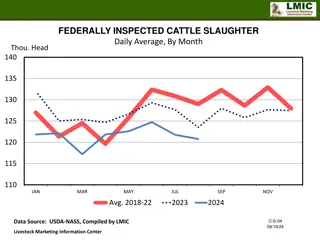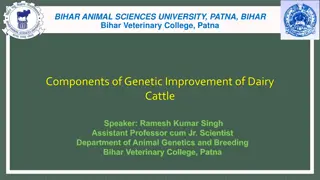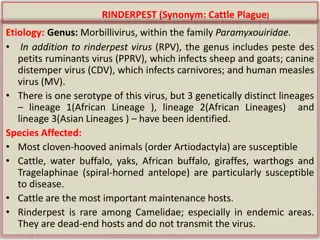Understanding Different Classes of Beef Animals and Their Grading
Different classes of beef animals, including cow, bull, calf, ox, heifer, and more, are discussed along with their characteristics and purposes. The process of grading beef, which provides information on taste and palatability, is also explained. Additionally, cuts of beef and their cooking methods
0 views • 20 slides
Understanding Bloat in Cattle: Causes, Symptoms, and Treatment
Bloat in cattle, characterized by overdistension of the rumenoreticulum with gases of fermentation, can be caused by various factors including diet, obstruction, or diseases. Frothy bloat and free gas bloat are common types, each with its own triggers and symptoms. Diagnosis involves a thorough hist
1 views • 8 slides
Understanding Expected Progeny Differences (EPDs) in Beef Cattle Selection
Expected Progeny Differences (EPDs) in beef cattle breeding predict future offspring performance based on genetic merit. They help compare animals as parents and aid in selecting for traits like birth weight, weaning weight, and yearling weight. Combining EPDs with visual appraisal improves decision
0 views • 15 slides
Livestock Breeding Policy for Genetic Improvement of Cattle and Buffalo in India
India's diverse agro-ecological regions host a wide range of farm animal breeds. The livestock breeding policy aims to enhance the productivity of cattle and buffalo through strategies such as grading up with indigenous superior dairy breeds, crossbreeding with high-yielding exotic breeds, and selec
1 views • 23 slides
Understanding Alkalosis in Cattle: Causes and Pathophysiology
Alkalosis in cattle, particularly ruminal alkalosis, can be caused by issues such as abomasal atony and alkaline indigestion. Excessive intake of protein-rich feed and changes in diet play a significant role. Pathophysiology involves the accumulation of ruminal ammonia, leading to alkaline pH and ru
1 views • 13 slides
Beef Concentrate Market ppt
Global Beef Concentrate Market Breakdown by Application (Food and Beverage Industry, Nutritional Supplements, Pet Food, Foodservice Sector) by Type (Liquid Beef Concentrate, Powdered Beef Concentrate, Paste Beef Concentrate) by Distribution Channel (
0 views • 8 slides
Actinobacillosis (Wooden Tongue) in Cattle and Sheep: Overview of the Infectious Disease
Actinobacillosis, also known as Wooden Tongue, is a specific infectious disease affecting cattle and sheep, caused by Actinobacillus lignieresii. It is characterized by fibrosis of the tongue and soft tissues, leading to mobility issues. The disease is primarily transmitted through wounds and abrasi
0 views • 8 slides
Understanding Bovine Virus Diarrhea and Mucosal Disease in Cattle
Bovine Virus Diarrhea (BVD) and Mucosal Disease (MD) are two clinically distinct yet interconnected syndromes in cattle caused by Pestivirus. While originally thought to be separate, they share a common viral etiology. BVD can lead to persistent infections, while MD is sporadic, progressive, and fat
0 views • 14 slides
Understanding Abomasal Displacement in Dairy Cattle: Causes, Symptoms, and Management
Abomasal displacement is a common issue in older lactating dairy cattle, often related to inadequate nutrition and concurrent diseases. This condition involves the displacement of the abomasum from its normal position, causing symptoms like anorexia, ketosis, and dehydration. Learn about the causes,
1 views • 21 slides
Understanding Sand Crack in Cattle Hooves: Causes, Signs, and Treatment
Sand crack, a fissure of the horny wall in cattle hooves, can present transversely or longitudinally. It commonly affects dairy breeds and is predisposed by various factors such as overgrowth of digital horn and chronic laminitis. Diagnosis and treatment differ based on the form of the crack, with s
0 views • 10 slides
Understanding Cattle Temperament: Implications for Producers
Cattle temperament plays a crucial role in the overall well-being of livestock and can impact factors such as stress levels, growth rates, and immune function. This article delves into the importance of evaluating and managing temperament in cattle to mitigate risks of injury, reduce stress-related
2 views • 32 slides
Common Infective Diseases in Cattle and Their Implications
Infective diseases such as blackquarter, brucellosis, and foot and mouth disease pose significant threats to cattle health and food safety. Blackquarter is a fatal disease caused by Clostridium chauvaei, while brucellosis leads to contagious abortion in cattle. Foot and mouth disease is highly conta
0 views • 17 slides
Dairy Cattle Production Systems in Ethiopia: Overview and Practices
Ethiopia has a favorable environment for dairy development with diverse production systems including pastoralism, agro-pastoralism, and mixed farming. The country boasts indigenous and exotic dairy cattle breeds, supporting milk production and utilization. This article outlines the different dairy p
2 views • 38 slides
Reducing Emissions in the Beef Sector: Draft Report from Food Vision Beef Group Meeting
Draft report from the Food Vision Beef Group's fourth meeting on September 1, 2022, at Backweston focuses on planning to reduce emissions associated with the beef sector. The report contains 17 measures derived from discussions held over the past two months.
1 views • 25 slides
Animal Husbandry Development Initiatives in India: Gaushalas and Gosadans
Animal Husbandry Development Programmes in India have a rich history dating back thousands of years, with initiatives like Gaushalas and Gosadans playing a significant role in preserving indigenous cattle breeds, promoting milk production, and supporting rural economies. Gaushalas aim to breed and u
0 views • 10 slides
Mineral Requirements for Beef Cows Demonstration Day at Tosca
Essential minerals play a crucial role in the growth and reproductive performance of beef cows. Divided into macro and micro categories, these minerals are necessary for skeletal development, milk production, and overall body function. While some minerals are readily available in forage, supplementa
0 views • 20 slides
History and Vocabulary of Cattle Farming
Explore the rich history of cattle farming, from the introduction of longhorn cattle in America by the Spanish to the importation of European dairy cattle to Jamestown Colony. Learn about various terms and concepts associated with cattle, such as castration, heifer, marbling, and more. Delve into th
0 views • 36 slides
Journey of Beef from Farm to Fork
Beef production involves a process starting from cattle farms where cows give birth to calves, followed by the growth stages including nursing, weaning, auction, grazing, feeding in feedyards, and eventually harvesting in processing facilities. The final beef cuts are distributed to supermarkets and
0 views • 11 slides
Addressing Challenges in the Cattle Market: A Call to Action
Explore the concept of Black Swan events in the cattle market and how they can affect market dynamics negatively. The presentation by R-CALF USA delves into instances where markets respond counter to fundamentals and overreact to minor stimuli. Issues such as high captive supply levels and import sp
0 views • 12 slides
Enhancing Cattle Farming with Assistive Technology in Nebraska
Nebraska AgrAbility specialists, Rodney Peterson and Emily Freudenburg, discuss the impact of modern equipment on cattle farmers with disabilities. They highlight the evolution of technology in cattle farming, introduce a new hydraulic feed box for efficient feeding, and provide vendor contact infor
0 views • 25 slides
Understanding Cattle Management and Classification
Cattle, belonging to the genus Bos, are classified into three types - Bos Taurus, Bos Indicus, and Bos Africans. They are ruminants with fixed hollow horns, udders with four teats, and males have teats on the scrotum. Cattle are utilized for milk production, agriculture, and meat manufacturing. They
0 views • 70 slides
Overview of Beef Farming in Ireland
The beef industry in Ireland plays a vital role in the country's agricultural economy, with millions of beef animals producing a significant amount of beef annually. However, despite its importance, beef farming has the lowest income per hectare compared to other farming types in Ireland. This overv
0 views • 72 slides
Beef Showmanship and Fitting Tips for Successful Campers
Explore essential tips for successful beef showmanship and fitting at camp in the River Valley District. Learn how to perfect your routine, enhance your skills, and excel on show day with expert guidance and insights. Whether you're a beginner or seasoned camper, these tips will help you elevate you
0 views • 4 slides
Feasibility Study: Measuring Ruminal Contractions of Cattle Using an Inexpensive Electronic Veterinary Stethoscope
Effects of gastrointestinal motility in understanding disease and nutrition in cattle are actively researched. This study explores monitoring ruminal contractions using a cost-effective electronic stethoscope. The device, developed with Arduino technology, showed promising results in capturing inter
0 views • 35 slides
Understanding the Lymphatic System in Cattle: Nodes, Circulation, and Function
The lymphatic system in cattle plays a crucial role in maintaining overall health. It consists of lymph nodes located in various regions of the body such as the head, neck, abdomen, and hind limbs. These lymph nodes produce lymphocytes and help in filtering foreign bodies. Lymph fluid, similar to bl
0 views • 39 slides
Tennessee 4-H Meat Judging Presentation: Beef Hindquarter Retail Cuts Identification
In this presentation featuring beef hindquarter retail cuts, students learn to identify different primal and retail cuts of beef such as Loin, Round, Sirloin, and Flank. Each cut is displayed with accompanying features to aid in recognition and understanding. The presentation helps students develop
0 views • 32 slides
Cattle Identification Methods and Characteristics Explained
Explore different methods of identifying cattle including collective and individual methods such as branding, tattooing, and tagging. Learn about cattle species, breeds, colors, and aging factors like dentition and parturition. Discover the main color variations in cattle such as yellow, red, black,
0 views • 36 slides
Livestock and Grains Situation and Outlook Analysis for January 2018
Brenda L. Boetel, a Commodity Marketing Specialist, evaluates the Livestock and Grains situation for January 2018. The analysis covers key aspects such as Commercial Meat & Poultry Production, Meat Disappearance in the US, Pork Production, Beef Export Trends, and Future Predictions for the Cattle In
0 views • 25 slides
Understanding Cattle Handling and Restraint Techniques
Explore the importance of understanding cattle senses and behaviors for effective handling and restraint. Learn about domestication history, handling techniques, sensory perception, and more to ensure safe interactions with cattle. Gain insights into vision, hearing, and other senses crucial for pro
1 views • 30 slides
Overview of Beef Cattle Breeds and Characteristics
In the United States, there are over 80 recognized breeds of beef cattle, each with its own advantages and disadvantages. British breeds like Angus and Hereford offer low birth weight and high fertility, while European breeds like Charolais and Simmental excel in growth rate and milk production. Oth
0 views • 24 slides
Protect Your Beef Cattle: Prevent Diseases and Ensure Animal Health
Diseases can harm the health of beef cattle and lead to costly consequences. Learn how to protect your herd by taking biosecurity measures to prevent the spread of diseases. This material, developed with support from USDA, emphasizes the importance of proactive steps to safeguard your beef cattle.
0 views • 5 slides
Comparing Natural Selection in Diverse Biomes: Spanish Cattle Adaptations
Explore the natural selection of Spanish cattle in desert, swamp, and grassland ecosystems. Compare characteristics of Cracker and Chinampo cattle, highlighting their adaptations for survival in different biomes. Discover how these species thrive in challenging environments through unique physical a
0 views • 11 slides
Brucellosis in Cattle and Buffaloes in Bikaner, Rajasthan, India
Brucellosis, caused by Brucella abortus, is a serious disease in cattle and buffaloes with significant public health and trade consequences. The disease is prevalent in India and poses a substantial economic impact. WHO recognizes brucellosis as a zoonotic disease, affecting both animals and humans.
0 views • 17 slides
Diverse Breeds of Dairy Cattle in India
Explore various breeds of dairy cattle in India, such as Murrah from Haryana, Surti Kaira from Gujarat, Jaffrabadi, Bhadawari, Nili Ravi, Mehsana, and Nagpuri. Each breed has unique characteristics like lactation yield, fat content, and breeding tracts. Discover the rich diversity and potential of I
0 views • 15 slides
Exploring Longhorn Cattle Genetics Through DNA Research
Longhorn cattle genetics are being investigated through DNA research to identify unique traits and differentiate them from other cattle breeds. By analyzing genetic codes with scatter plot graphs, scientists aim to map the genetic makeup of Longhorns accurately. This research helps in understanding
0 views • 9 slides
Kentucky Cattlemen's Association Long-Range Plan Overview
Kentucky Cattlemen's Association has outlined a comprehensive long-range plan for 2020-2025, focusing on cultivating value-added marketing opportunities, strengthening research and outreach, enhancing engagement and advocacy, and developing organizational infrastructure. The plan includes strategies
1 views • 11 slides
Overview of Federally Inspected Cattle Slaughter Data
This data compilation provides insights into federally inspected cattle slaughter on a daily, weekly, and monthly basis, along with specific details on cow slaughter, commercial cattle slaughter, heifer slaughter, cow slaughter, steer slaughter, and beef cow slaughter. The information covers average
0 views • 16 slides
Respiratory Diseases in Cattle: Causes, Infections, and Management
Respiratory diseases in cattle primarily stem from infectious agents such as infectious bovine rhinotracheitis and Pasteurella spp. These diseases compromise the defense mechanisms of the body, leading to infections like pneumonia and pleuropneumonia. Viruses, mycoplasmas, and bacteria like Histophi
0 views • 31 slides
Genetic Improvement of Dairy Cattle: Key Components and Strategies
Understanding the genetic improvement of dairy cattle is crucial for enhancing milk production. This article explores the key components involved, such as unique identification systems, parentage recording, milk yield monitoring, artificial insemination, and genetic evaluation methods. Achieving exc
0 views • 11 slides
Understanding Rinderpest: A Cattle Plague Overview
Rinderpest, also known as Cattle Plague, is caused by the Morbillivirus and primarily affects cloven-hooved animals like cattle and buffalo. It is transmitted through contact with infected animals and has distinct clinical signs ranging from fever and mucopurulent secretions to severe hemorrhagic di
0 views • 14 slides
